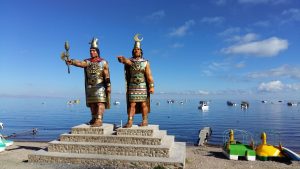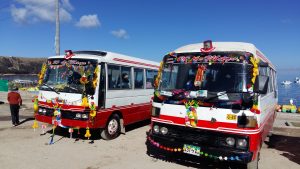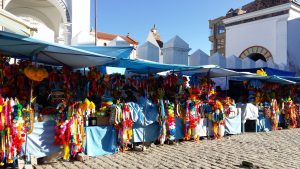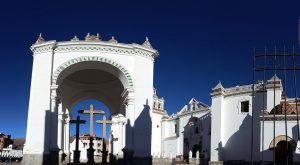Titicaca… the highest lake in the world. More accurately the highest navigable lake, although we don’t know exactly what the difference is. It sits at 3,700m on the altiplano and straddles the Bolivia/Peru border. Bolivia has more than a fair share of natural beauty and this is yet another example of its best. A fitting exit point for us from this scenic country (Click here for route map).

The Lake
Diligent readers of Cuthbert’s last blog may recall that on our route from the Amazon, mud-slides and unseasonally wet conditions forced us to return to La Paz rather than take a more round-about route through the Cordillera Real mountains to Lake Titicaca. One visit to La Paz in a month would, under normal circumstances be more than enough for most travellers, but here we find ourselves again, doing battle with the chaos that is La Paz traffic. Needless to say, we don’t stay long and are soon on our way north.
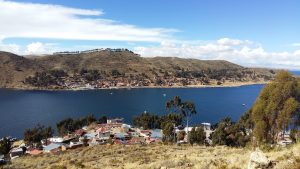 We’re heading to Copacabana. No, not the famous miles of golden sands of Río de Janeiro, but a popular resort town on Bolivia’s southern shore of Lake Titicaca. This Lake is one of those places that children all over the world learn about at school and ever since those days (hmmph years ago 🙂 ) a visit here has been on my ‘to do’ list. As we approach from the south, our first sight of the Lake doesn’t disappoint. On the eastern side the Lake is surrounded by the beautiful high mountains of the Cordillera Real (yes, the very mountains that we had originally planned on crossing to avoid La Paz) but one look at them from this side confirmed that we had indeed made the right decision to skirt around them. The rain that had fallen to cause mud-slides for us on the lower eastern side had fallen as heavy snow on the higher ground. The route through these mountains would certainly have been impassable and attempting to do so would have been dangerous or stupid or both. Nevertheless, from the lake-shore we can now at our leisure, enjoy the scenery of the very white mountains behind the blue lake. It’s a special ‘so glad to make it here’ moment for us and we stop a while to take in the beautiful views.
We’re heading to Copacabana. No, not the famous miles of golden sands of Río de Janeiro, but a popular resort town on Bolivia’s southern shore of Lake Titicaca. This Lake is one of those places that children all over the world learn about at school and ever since those days (hmmph years ago 🙂 ) a visit here has been on my ‘to do’ list. As we approach from the south, our first sight of the Lake doesn’t disappoint. On the eastern side the Lake is surrounded by the beautiful high mountains of the Cordillera Real (yes, the very mountains that we had originally planned on crossing to avoid La Paz) but one look at them from this side confirmed that we had indeed made the right decision to skirt around them. The rain that had fallen to cause mud-slides for us on the lower eastern side had fallen as heavy snow on the higher ground. The route through these mountains would certainly have been impassable and attempting to do so would have been dangerous or stupid or both. Nevertheless, from the lake-shore we can now at our leisure, enjoy the scenery of the very white mountains behind the blue lake. It’s a special ‘so glad to make it here’ moment for us and we stop a while to take in the beautiful views.
Don’t pay the ferryman…until he gets you to the other side
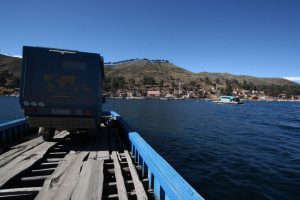
Drive between the gaps (note bus on distant barge!)
Famous words by Chris de Burgh, well… famous if you’re a Chris de Burg fan at least. But what on earth has this to do with our route to Copacabana? Well… to get there we need to cross a narrow straight of water across the southern end of the Lake to the Copacabana peninsula. We have heard from other travellers, tales of rickety barges that shuttle vehicles across this water, but we have also been assured that these barges, rickety as they may seem, carry large lorries and buses all day across the straights. So Cuthbert should be fine then.
As we approached the straights we could indeed see a large bus on one of said barges being schlepped across the water. But somehow or other, we were allocated a barge that seemed even more rickety than your average rickety barge. The sides looked ok, but the ‘deck’ (such term used in the loosest sense of the word) looked little more than a bundle of loosely connected planks, with volumes of water sloshing around between them. We hesitated at the sight, but the ferryman seemed confident and marshalled Cuthbert into place before putting an improvised chock (just a large pebble really) under one wheel. One disconcerting aspect was how the whole frame of the barge seemed to twist and flex as Cuthbert’s weight transferred, one axle at a time, onto the deck. Nevertheless, the barge seemed to take Cuthbert’s weight and the ferryman used a pole to punt us out to water deep enough to start the little engine.
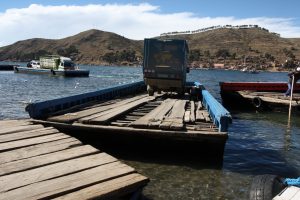
Bit of trouble getting to land on arrival
As we continued further out into the water Cuthbert began to roll quite widely on his suspension, causing the barge to rock and roll in the water. The barge frame continued to twist and creak loudly while more water was seeping between the planks. We were comforted by the thought that we were making good progress and would be there soon. This thought however, fell firmly foul of that English proverb about ‘counting your chickens before they’ve hatched’. Mid-way, the little two-stroke engine started to splutter. It was running out of fuel! The ferryman started manually pumping the last dregs of fuel into the motor which finally expired just before we reached the shore. More water was coming on board as the ferryman punted us the last 50m to the shore. Finally, on arrival all Marcus had to do was drive Cuthbert onto the shore, but the ferryman was having difficulty in securing the barge to the land and there wasn’t much of a firm bridge for Cuthbert to disembark. All in all the whole ‘voyage’ was a slightly harrowing experience. With hindsight, we should probably have rejected that particular barge and asked for one of the several others that looked, shall we say… more serviceable. Never mind… we made it over! 🙂
Copacabana
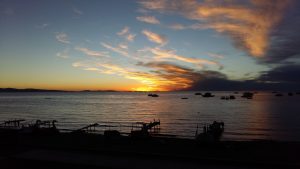
Copacabana sunset
The drive from the ‘ferry’ to Copacabana continued in the same scenic theme as before the crossing and we really liked the little town when we got there. It is a mixture of a local community, with regional tourism and international travellers. It has a rather ‘chilled-out’ vibe, great sunset views over the Lake and a stylish Cathedral unlike any we had seen in the rest of Bolivia.
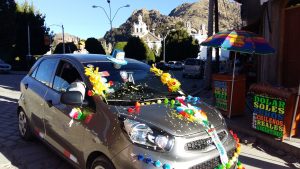
Ready for blessing
The town is only about 5km from the Peruvian border and when we arrived, the lakefront was full of Peruvian visitors who had brought their cars and buses to be blessed by Copacabana’s priest. In tribute to the occasion they had all decorated their vehicles with flowers and colourful adornments. The blessing is known as cha’lla and a ritual pouring of alcohol over the vehicle consecrates it for future journeys. It looked like a great family occasion and they were all having a fun time celebrating.
Bye Bolivia
Anyway… after a short stop in Cool Copacabana, we’ve reached the end of Bolivia and it’s time to say ‘over and out’. We’ve spent just over eight weeks in the country and although our initial few days were unremarkable, the country did start to grow on us when we came back here from Brazil.
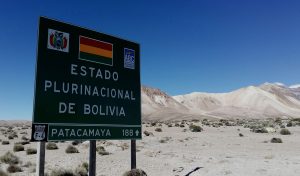 So what have we made of Bolivia? Well first of all it’s a hugely diverse country with the most significant division being between the western altiplano and the eastern lowlands. The popular image of the colourful, chunky Bolivian altiplano peasant farmer herding his llamas around the Andes is certainly a familiar sight in those parts. However, there is a less widely known culture from the jungle and the lowlands which form around two thirds of the country. The diversity of many ethnic backgrounds has led Bolivia to label itself with the inclusive term The Plurinational State of Bolivia.
So what have we made of Bolivia? Well first of all it’s a hugely diverse country with the most significant division being between the western altiplano and the eastern lowlands. The popular image of the colourful, chunky Bolivian altiplano peasant farmer herding his llamas around the Andes is certainly a familiar sight in those parts. However, there is a less widely known culture from the jungle and the lowlands which form around two thirds of the country. The diversity of many ethnic backgrounds has led Bolivia to label itself with the inclusive term The Plurinational State of Bolivia.
The country has had a difficult history and has lost through various wars, large tracts of land to several neighbours. The most significant loss was in 1884 when they lost to Chile their access to the Pacific coast, leaving Bolivia a land-locked country. The right of access to the coast is still today a very sore point in Bolivia, with a current legal action pending in The Hague. The country’s claim to maritime access is still very much being kept alive for future generations by teaching in schools.
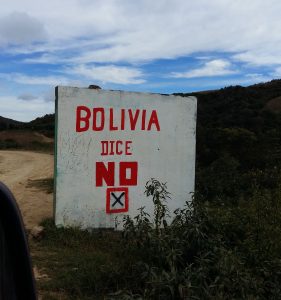 Evo Morales has been El Presidente since 2006 and is the country’s first indigenous national leader. With his left-wing policies he has had considerable success keeping the comrades on his side. Throughout the country are many green-painted signs of ‘Evo Sí’ and he is certainly not shy about putting his face on posters around the country. However, from local media and a few discussions with local people, we gather that Old Evo’s popularity may now be slightly on the wane. We noticed a few red-painted ‘Bolivia dice No’ (Bolivia says No) signs around the far south of the country in opposition to his re-election. Time will tell for the people of Bolivia, but for the tourist (provided they are not unfortunate enough to be caught by one of the increasingly common protests and road-blocks around the country) Bolivia is a worthwhile visit with plenty to see and do. The people are probably not the most immediately warming, but they are polite, cheerful and we were particularly impressed in many places with their positive approach to their tourism industry. The national infrastructure is still very much a ‘work in progress’ in places, but the main inter-city highways are excellent.
Evo Morales has been El Presidente since 2006 and is the country’s first indigenous national leader. With his left-wing policies he has had considerable success keeping the comrades on his side. Throughout the country are many green-painted signs of ‘Evo Sí’ and he is certainly not shy about putting his face on posters around the country. However, from local media and a few discussions with local people, we gather that Old Evo’s popularity may now be slightly on the wane. We noticed a few red-painted ‘Bolivia dice No’ (Bolivia says No) signs around the far south of the country in opposition to his re-election. Time will tell for the people of Bolivia, but for the tourist (provided they are not unfortunate enough to be caught by one of the increasingly common protests and road-blocks around the country) Bolivia is a worthwhile visit with plenty to see and do. The people are probably not the most immediately warming, but they are polite, cheerful and we were particularly impressed in many places with their positive approach to their tourism industry. The national infrastructure is still very much a ‘work in progress’ in places, but the main inter-city highways are excellent.
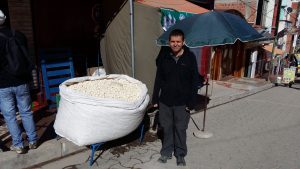
Can’t complain about the size of Bolivian popcorn bags
On the road, we didn’t find the police to be as corrupt as we had been led by other travellers to believe. One of the main controversial points for overlanding drivers remains the supply of fuel for vehicles. This can be problematic and we have written a separate note about this for anyone interested in the nitty-gritty (click here).
One small criticism we could mention of the Bolivians: they seem to have no interest whatsoever in the Olympics!!! It has been a bit frustrating trying to find places with a t.v. on which we can watch some of Team GB’s great performances in Río. Oh well… the price we pay for the itinerant life-style.
All in all, we’ve really enjoyed Bolivia, but it’s time to move on. Peru is calling and we are particularly excited to be meeting-up soon with some very good friends; Jimmy and Karen are flying out from UK to Cusco on holiday to meet us in a few weeks. Soooo looking forward to seeing them and the rest of Peru 🙂
Link to next blog: Incas and Reeds Link to full South America Blog
Link to Bolivia Photo Gallery

